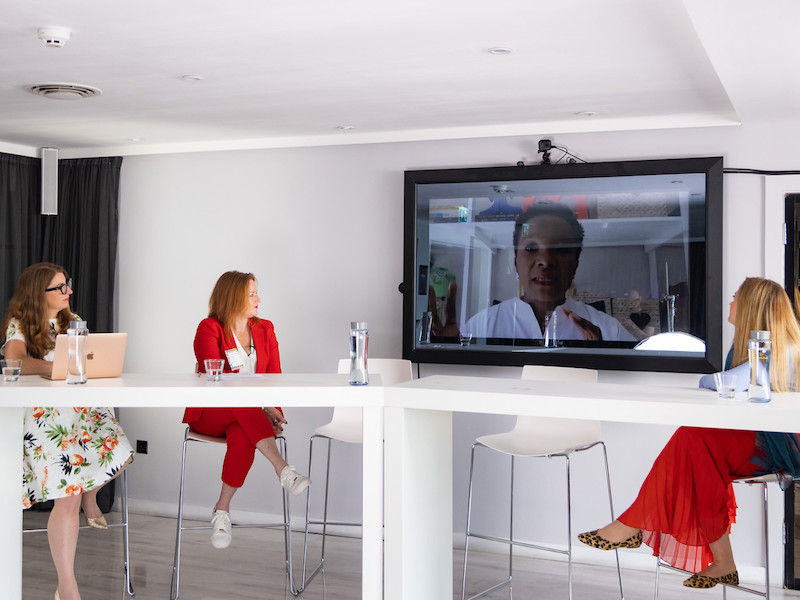Maja Pawinska Sims 28 Jun 2021 // 7:21PM GMT

BRIGHTON — There is no reason why legacy companies in traditional, highly-regulated sectors cannot be as creative as big FMCG brands, said speakers at Cannes Condensed.
On a panel discussion entitled “Creativity for the uncool” at the hybrid event, senior in-house communications leaders from the insurance and financial services sectors were joined by Rachel Gilley, UK managing director and EMEA president of technology agency Clarity, who said traditional industries – from agriculture and financial services to law and property – raised different questions about how to approach creativity.
“There are some tenets that still ring true, but maybe it is easier to be creative in a start-up or scale-up, where there are flatter hierarchies, you can pivot more quickly, and people maybe feel more at ease with conflict than in larger organisations where there are more approval processes and silos.”
However, she said the bottom line was that “anyone can be creative”: “There’s no reason why large traditional organisations can’t be creative. You’ve just got to allow people to speak up, allow that element of contention, flatten hierarchies and get everyone involved.”
Joining the session in Brighton down the line from Johannesburg, Nontokozo Madonsela, group CMO of Momentum Metropolitan Holdings, said she had brought her many years of marketing experience on soft drinks, tobacco and beer brands into the financial services sector.
“It has served me well in terms of how I lead and push the boundaries. A lot of financial services businesses try and recruit from within the sector, but ultimately all marketing is about changing human behaviour, whatever you are selling,” she said.
“I love reminding my team that we are talking to humans with emotion and we are in a space where there is so much competition for attention, and that has helped to unlock how our brands go to market. Some things are seen as creative only because they haven’t ever been done within that business.”
Asked how wild marketing can get in a regulated industry, Madonsela said: “What’s important for us is that we never overpromise. We stay true to what we technically offer, we make sure there is rigour in legal sign-off and we don’t mess around with that, but where we push the boundaries is where we talk about the product. When we are educating people about estate planning, writing wills and investing, we need to think about how we disrupt and get attention.”
Also on the panel was Lynzi Ashworth, EMEA head of digital marketing for insurance giant Aon, who said another key issue in highly-regulated and mature sectors was articulating the reason for pushing creative boundaries: “Like any brand, we can be creative for the sake of being creative, but it’s about asking what is our ‘why?’ and what is our customers’ ‘why?’, and for us that’s about changing perceptions of what we can help clients with.
“Insurance is more important than ever because risks are changing: where our brokers were traditionally looking after property, casualty and liabilities, the biggest risks to business now are intellectual property and talent. Where those needs are changing, we’ve had to think about how we position ourselves and tell stories that get past the boundaries of what we’ve been known for as a brand.”
Ashworth said the pandemic had also impacted on traditional firms’ approach to marketing and communications: “Everyone has been pushed to their own emotional boundaries, and it’s changing the way brands talk to people. In the insurance and finance industry, we don’t want to scare people into buying products, but we can talk about protecting the people and things you love, and that message resonates more than ever.
“And because more organisations are suddenly more focused on employees’ wellbeing, a lot of our marketing has been focuses on helping them with that.”
In a discussion on budgets, the panellists agreed that – as ever in communications – proving return on spend on creativity was just as difficult in traditional industries as in other sectors.
At Momentum Metropolitan, Madonsela said her team applied a 70/20/10 formular to budgeting: “70% of our budget is allocated to activities we are almost certain will work; 20% is allocated to activities that were experiments in the prior year so we can learn and tweak and prove the results, and 10% are experiments or initiatives that can fail, but for marketers its essential we try new things. We’re not gambling too much – it gives us guard rails to provide a bit of comfort.”
From the agency point of view on making the case for investment in creativity, Gilley said: “A lot of our larger clients are interested in what we’ve been doing for start-ups and scale-ups. We talk a lot to them about not being cowed by legacy structures and give them examples to feed back to their FDs who need to be convinced it’s something that can work and have impact.
“It’s easier as the agency to encourage traditional clients to be more playful – and where you do get a creative idea right in a traditional industry, employees become another audience and the pride internally is enormous.”
Finally, Ashworth said her top tips for communicators within traditional businesses who wanted their teams to push creative boundaries were: “Give people space and time to be creative and curious and play with ideas; let them know that they have permission to fail; and question everything, including ‘why have we always done it like that?’”
Watch the full session here:



































.jpg)

















